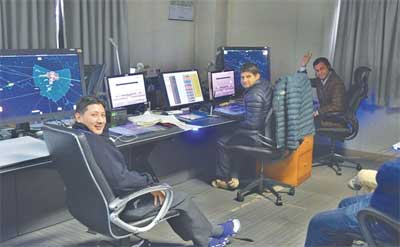

TIA to operate 21 hours a day from May 21 to handle more flights

Tribhuvan International Airport (TIA) plans to remain open for 21 hours a day to handle a growth in flights and provide incentives to air traffic controllers (ATCs) and other staff as compensation for the increased workload.
The new schedule will be implemented from May 21, and airport authorities have proposed asking employees to work an hour extra daily as TIA suffers from a shortage of experienced manpower. Currently, the airport operates for 18 hours 30 minutes daily.
“Given the existing manpower, it is difficult to operate 24/7. But we can stay open for another 2 hours 30 minutes daily. This means each shift will be lengthened by 1 hour,” said Raj Kumar Chettri, general manager of TIA. “They will be given incentives for the extra workload.” Chettri said that a few airlines had expressed interest in operating during the night-time as they think it is better than holding for hours in the skies before landing during the daytime.
Traffic congestion is also severe on the ground due to a limited number of parking bays. Experts said that TIA had turned into a ‘roll and hold’ airport as its existing infrastructure has not been able to cope with the rising travel demand.
“The existing infrastructure bottleneck has particularly been a huge setback for the country’s tourism,” said an aviation expert. “Nepal is now served by 28 international airlines, and it is already saturated,” he said. For the last 50 years, the government has not realized that Nepal needs an airport with a parallel runway, he added. However, TIA is not expected to see visible change in terms of reducing traffic congestion even after operating the airport for an additional 2 hours 30 minutes daily as the summer schedule of all airlines has already been approved.
“But it will definitely help during the next peak tourist season which starts in September,” said Chettri. Most of the international flights operate between 1 and 5 pm, the peak travel time, resulting in chaos for airlines and ATCs. Traffic is thin in the mornings till 12 noon and from 6 to 9 pm.
Chettri said that TIA would not issue slots for new airlines from 11 am to 5 pm, the peak travel time. “New entrants or existing ones planning to operate additional flights will have to come during the night.” According to Chettri, nearly 70 percent of the international traffic is concentrated during the peak time.
During the tourist season, March-May and September-November, TIA handles more than 500 flights daily, 75 percent of them domestic flights. The sole reason behind the congestion at TIA during the tourist season is Lukla flights. And if a flight to Lukla, the gateway to Everest, is disrupted on any particular day due to weather, its rescheduling will create a cascading effect on all flights.
For example, Lukla witnessed a record 130 flights (take-off and landing) on a day last April. In such a situation, if a flight is disrupted due to bad weather in Lukla, its rescheduling will create massive chaos at TIA, hampering smooth operation of international flights.
TIA’s traffic statistics show that Lukla airport in the Himalaya is the third busiest airport in Nepal after TIA and Pokhara. Lukla airport, which has a 527-metre runway, is listed among the Most Extreme Airports by the History Channel.
This is not the first time that the government has announced keeping TIA open longer. In 2011, when the country observed Nepal Tourism Year, the government had decided to operate TIA 24 hours a day. However, the plan fell apart after its sole runway started to crumble. Repeated occurrences of cracks on the runway at the country’s sole international aerial gateway have been affecting smooth operation of aircraft since 2011. Scores of flights have been diverted or delayed in recent years due to problems in the runway. Cracks were reported occasionally in 2012.
The problem worsened in 2013, forcing the Civil Aviation Authority of Nepal (Caan) to take a harsh decision to bar aircraft weighing more than 196 tonnes from landing at TIA. The restriction is still in place.
“Obviously, runway cracks are also an issue,” said Chettri. “To resolve this problem, we have decided to use the latest technological or chemical mixture that offers faster set times, higher early strengths and better durability,” he said. “The mixture dries in less than 30 minutes,” he said.
source:the kathmandu post,19 april 2018








